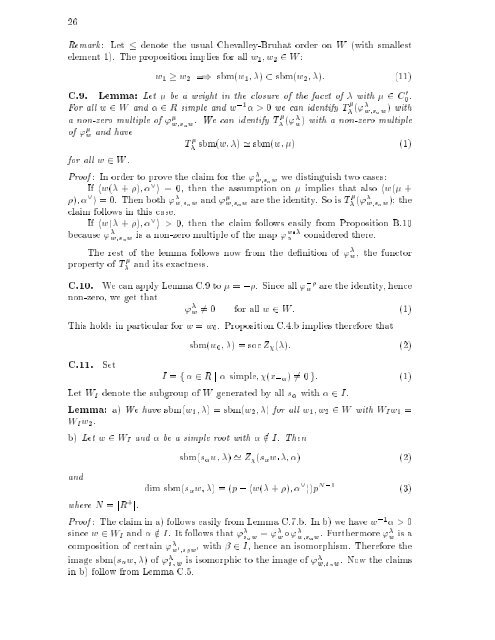subregular nilpotent representations of lie algebras in prime ...
subregular nilpotent representations of lie algebras in prime ...
subregular nilpotent representations of lie algebras in prime ...
You also want an ePaper? Increase the reach of your titles
YUMPU automatically turns print PDFs into web optimized ePapers that Google loves.
26<br />
Remark: Let denote the usual Chevalley-Bruhat order on W (with smallest<br />
element 1). The proposition imp<strong>lie</strong>s for all w1;w2 2 W :<br />
w1 w2 =) sbm(w1; ) sbm(w2; ): (11)<br />
C.9. Lemma: Let be a weight <strong>in</strong> the closure <strong>of</strong> the facet <strong>of</strong> with 2 C 0<br />
0 .<br />
For all w 2 W and 2 R simple and w ,1 >0 we can identify T (' w;s w) with<br />
a non-zero multiple <strong>of</strong> ' w;s w . We can identify T (' w ) with a non-zero multiple<br />
<strong>of</strong> ' w and have<br />
T sbm(w; ) ' sbm(w; ) (1)<br />
for all w 2 W .<br />
Pro<strong>of</strong> : In order to prove the claim for the ' w;s w we dist<strong>in</strong>guish two cases:<br />
If hw( + ); _ i = 0, then the assumption on imp<strong>lie</strong>s that also hw( +<br />
); _ i = 0. Then both ' w;s w and ' w;s w are the identity. SoisT (' w;s w); the<br />
claim follows <strong>in</strong> this case.<br />
If hw( + ); _ i > 0, then the claim follows easily from Proposition B.10<br />
because ' w;s w is a non-zero multiple <strong>of</strong> the map ' w considered there.<br />
The rest <strong>of</strong> the lemma follows now from the de nition <strong>of</strong> ' w, the functor<br />
property <strong>of</strong>T and its exactness.<br />
C.10. We can apply Lemma C.9 to = , . S<strong>in</strong>ce all ' , non-zero, we get that<br />
w are the identity, hence<br />
'w 6= 0 for all w 2 W . (1)<br />
This holds <strong>in</strong> particular for w = w0. Proposition C.4.b imp<strong>lie</strong>s therefore that<br />
C.11. Set<br />
sbm(w0; )=socZ ( ): (2)<br />
I = f 2 R j simple; (x, ) 6= 0g: (1)<br />
Let WI denote the subgroup <strong>of</strong> W generated by alls with 2 I.<br />
Lemma: a) We have sbm(w1; ) = sbm(w2; ) for all w1;w2 2 W with WIw1 =<br />
WIw2.<br />
b) Let w 2 WI and be a simple root with =2 I. Then<br />
and<br />
where N = jR + j.<br />
sbm(s w; ) ' Z (s w ; ) (2)<br />
dim sbm(s w; )=(p ,hw( + ); _ N ,1<br />
i)p<br />
Pro<strong>of</strong> : The claim <strong>in</strong> a) follows easily from Lemma C.7.b. In b) we have w ,1 >0<br />
s<strong>in</strong>ce w 2 WI and =2 I. It follows that ' s w = ' w ' w;s w. Furthermore ' w is a<br />
composition <strong>of</strong> certa<strong>in</strong> ' w 0 ;s w 0 with 2 I, hence an isomorphism. Therefore the<br />
image sbm(s w; )<strong>of</strong>' s w is isomorphic to the image <strong>of</strong> ' w;s w .Now the claims<br />
<strong>in</strong> b) follow from Lemma C.5.<br />
(3)

















